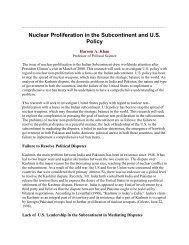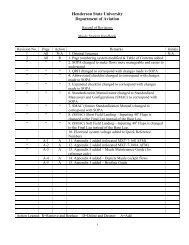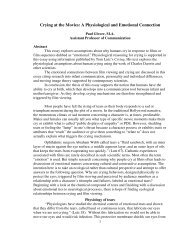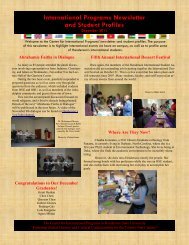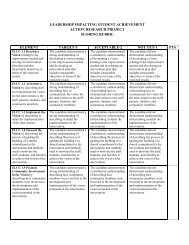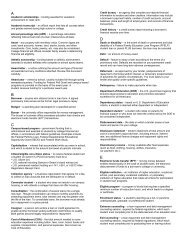Birds Breaching Two Worlds in The Iliad - Henderson State University
Birds Breaching Two Worlds in The Iliad - Henderson State University
Birds Breaching Two Worlds in The Iliad - Henderson State University
Create successful ePaper yourself
Turn your PDF publications into a flip-book with our unique Google optimized e-Paper software.
Biographical Sketch<br />
Fred Worth received his B.S. <strong>in</strong> Mathematics from Evangel College <strong>in</strong> Spr<strong>in</strong>gfield,<br />
Missouri <strong>in</strong> 1982. He received his M.S. <strong>in</strong> Applied Mathematics <strong>in</strong> 1987 and his Ph.D. <strong>in</strong><br />
Mathematics <strong>in</strong> 1991 from the <strong>University</strong> of Missouri at Rolla. He has been teach<strong>in</strong>g at<br />
<strong>Henderson</strong> <strong>State</strong> <strong>University</strong> s<strong>in</strong>ce August, 1991. Among his professional affiliations is<br />
his membership <strong>in</strong> the Society for American Baseball Research, home to hundreds of<br />
baseball geeks.<br />
<strong>Birds</strong> <strong>Breach<strong>in</strong>g</strong> <strong>Two</strong> <strong>Worlds</strong> <strong>in</strong> <strong>The</strong> <strong>Iliad</strong><br />
Élan Potter, M.L.A.<br />
Mentor: Dr. Marck L. Beggs<br />
Professor of English and Graduate Dean<br />
Mentor: Ms. Tricia Baar<br />
Instructor of English<br />
Abstract<br />
<strong>The</strong> Greeks, like their Asiatic counterparts, frequently assigned natural symbols to their<br />
pantheon of gods and goddesses, and one animal <strong>in</strong> particular dom<strong>in</strong>ates the diverse<br />
animalistic connections to the pantheon – birds. Naturally, these same relationships<br />
between gods and animals can be seen <strong>in</strong> Greek literature. Specifically, bird imagery<br />
abounds <strong>in</strong> <strong>The</strong> <strong>Iliad</strong>, usually <strong>in</strong> connection with the gods’ communication with mortals.<br />
This appearance of birds with div<strong>in</strong>e/mortal communication parallels how birds traverse<br />
the two worlds <strong>in</strong> nature of sky and land. <strong>The</strong> ability of birds to pass from one world to<br />
another contributes to an otherworldl<strong>in</strong>ess that is also descriptive of the Greek pantheon<br />
of gods. This appearance of bird imagery <strong>in</strong> <strong>The</strong> <strong>Iliad</strong> functions <strong>in</strong> three specific ways<br />
with<strong>in</strong> the text: to transmit future events to mortals through omens, to facilitate direct<br />
communication between gods and mortals, and to characterize the pass<strong>in</strong>g of mortals <strong>in</strong>to<br />
the afterlife. All of these methods demonstrate how the gods through bird-like actions<br />
and communication assist men <strong>in</strong> their daily lives.<br />
***<br />
Historically, the natural world has been associated with div<strong>in</strong>ity. <strong>The</strong> chang<strong>in</strong>g of<br />
seasons was attributed to div<strong>in</strong>e forces. Fair weather and good harvests could be viewed<br />
as div<strong>in</strong>e bless<strong>in</strong>gs, while natural disasters could be expla<strong>in</strong>ed as punishment by the<br />
div<strong>in</strong>e for mortal s<strong>in</strong>s. <strong>The</strong> work<strong>in</strong>gs of nature were largely unexpla<strong>in</strong>able, and vary<strong>in</strong>g<br />
forms of religiosity arose to provide explanations for natural phenomena. As religions<br />
became more established, gods and goddesses arose throughout Asiatic religions, and<br />
each god acquired natural symbols “represented either <strong>in</strong> connection with the figures of<br />
the div<strong>in</strong>ities, or <strong>in</strong> place of them” (Froth<strong>in</strong>gham 59). <strong>The</strong> Greeks, <strong>in</strong> turn, borrowed this<br />
practice of assign<strong>in</strong>g natural symbols to their pantheon of gods and goddesses from Asia<br />
(Froth<strong>in</strong>gham 61), and these symbols were frequently animals that could convey<br />
29
someth<strong>in</strong>g of the special powers of each god.<br />
Although there are diverse animalistic connections with the Greek gods, El<strong>in</strong>or<br />
Bev<strong>in</strong>’s exam<strong>in</strong>ation of ancient sanctuaries reveals that one animal <strong>in</strong> particular<br />
dom<strong>in</strong>ated these connections: “In sixty or more sanctuaries . . . over 1000 birdrepresentations<br />
came to light . . . Accord<strong>in</strong>g to the available evidence, birds of all or any<br />
k<strong>in</strong>d were found <strong>in</strong> far greater numbers . . .” (163). Evidently, the perceived connection<br />
between birds and gods was significant for the Greeks; this connection may best be<br />
fleshed out through an exam<strong>in</strong>ation of Greek literature.<br />
In Homer’s <strong>The</strong> <strong>Iliad</strong>, bird imagery abounds <strong>in</strong> connection with the div<strong>in</strong>e,<br />
normally when contact exists between the div<strong>in</strong>e and mortal realms. <strong>The</strong> use of birds to<br />
convey messages to earth from lofty Olympus is natural, as birds evidently traverse the<br />
worlds of air and land. Bird imagery functions <strong>in</strong> three specific ways with<strong>in</strong> the text: (1)<br />
to transmit future events to mortals through omens, (2) to facilitate direct communication<br />
between gods and mortals, and (3) to characterize the pass<strong>in</strong>g of mortals <strong>in</strong>to the afterlife.<br />
All of these methods demonstrate how the gods assist men <strong>in</strong> their daily lives.<br />
<strong>Birds</strong> are apt symbols of div<strong>in</strong>ity, as they are otherworldly; they are creatures of<br />
the air and their migratory movements foreshadow the change of seasons. In <strong>The</strong> <strong>Iliad</strong>,<br />
birds provide noteworthy omens to the men below. For example, Odysseus relates a sign<br />
of a snake devour<strong>in</strong>g a sparrow and eight of her children, “so for years as many as this<br />
shall we fight <strong>in</strong> this place and <strong>in</strong> the tenth year we shall take the city of the wide ways”<br />
(84-85). Here, the div<strong>in</strong>ely sent omen gives the Achaians the knowledge that, despite<br />
n<strong>in</strong>e years of fight<strong>in</strong>g, they will ultimately prevail over the Trojans <strong>in</strong> the tenth year. <strong>The</strong><br />
death of each bird stands for one unsuccessful year of battle. <strong>The</strong> snake, however, is a<br />
traditional symbol of rebirth, stemm<strong>in</strong>g from its slough<strong>in</strong>g of sk<strong>in</strong>. So, the snake’s<br />
triumph over the sparrows foreshadows the Achaians’ ultimate triumph <strong>in</strong> the follow<strong>in</strong>g,<br />
or tenth, year. This div<strong>in</strong>ely given sign rek<strong>in</strong>dles the Achaians’ morale as the gods had<br />
communicated favor toward them <strong>in</strong> battle.<br />
When Zeus later sends his eagle <strong>in</strong> answer to Agamemnon’s prayer to save the<br />
ships from the Trojans, the l<strong>in</strong>k between birds and gods as messengers becomes clearer:<br />
He spoke thus, and as he wept the father took pity on him and bent his head, that<br />
the people should stay alive, and not perish. Straightway he sent down the most<br />
lordly of birds, an eagle, with a fawn, the young of the runn<strong>in</strong>g deer, caught <strong>in</strong> its<br />
talons, who cast down the fawn beside Zeus’ splendid altar . . . <strong>The</strong>y, when they<br />
saw the bird and knew it was Zeus who sent it, remembered once aga<strong>in</strong> their war<br />
craft, and turned on the Trojans. (188-189)<br />
Although Zeus appears to send the fawn to earth, the focus of the omen is on the eagle<br />
and its strength. <strong>The</strong> “lordly” eagle of Zeus gives the Achaians fortitude aga<strong>in</strong>st the<br />
Trojans. Not surpris<strong>in</strong>gly, the eagle is traditionally associated with Zeus. As Apostoles<br />
notes, “<strong>The</strong>y say that the eagle was born at the time of the birth of Zeus and that <strong>in</strong> the<br />
battle aga<strong>in</strong>st the Giants it flew by his side. Consequently, when the birds were divided<br />
among the Gods, Zeus chose the eagle” (qtd. <strong>in</strong> Mylonas 203). <strong>The</strong> eagle is Zeus’s<br />
companion and helper, so the eagle’s appearance to the Achaians is comparable to the<br />
appearance of Zeus himself to show mercy and favor.<br />
30
This <strong>in</strong>timate relationship between Zeus and the eagle <strong>in</strong> augury is seen aga<strong>in</strong> <strong>in</strong> a<br />
warn<strong>in</strong>g to the Trojans. Before Hektor leads the Trojans across the ditch <strong>in</strong> order to set<br />
fire to the Achaian ships, Zeus sends an eagle fly<strong>in</strong>g to the left with a serpent <strong>in</strong> its talons.<br />
<strong>The</strong> serpent bites the eagle, and the eagle drops his prey (263). In augury, birds fly<strong>in</strong>g to<br />
the left is bad luck, while fly<strong>in</strong>g to the right is good luck. One way of <strong>in</strong>terpret<strong>in</strong>g the<br />
bird sign can be to view the eagle fly<strong>in</strong>g on the left as the Trojans, carry<strong>in</strong>g the snake that<br />
embodies the rebirth of their victory aga<strong>in</strong>st the Achaians. Yet, s<strong>in</strong>ce the eagle is on the<br />
left and drops that victory, it foreshadows the change <strong>in</strong> the tide of the war. This is how<br />
Poulydamas appears to <strong>in</strong>terpret the sign to Hektor, say<strong>in</strong>g that the eagle “let it drop<br />
suddenly before w<strong>in</strong>g<strong>in</strong>g home, and could not f<strong>in</strong>ish carry<strong>in</strong>g it back to give to his<br />
children” (264). Poulydamas, however, does not expla<strong>in</strong> the significance of the bite;<br />
therefore, this <strong>in</strong>terpretation may not be satisfactory. Yet, there is an alternate<br />
<strong>in</strong>terpretation of the eagle represent<strong>in</strong>g Zeus and the serpent stand<strong>in</strong>g for the Trojans.<br />
<strong>The</strong> Trojans have been experienc<strong>in</strong>g a type of rebirth through their victories after<br />
Achilles’s retreat from the battle, and these victories have been enabled by Zeus despite<br />
his ultimate promise to Hera that the Achaians will prevail. Zeus carries the Trojans <strong>in</strong><br />
the same way that the eagle carries the serpent. Hektor ignores the bird sign, refus<strong>in</strong>g to<br />
trust Zeus’s omen. This refusal to heed the omen, which is foreseen by the gods, is the<br />
serpent’s bite that spurs Zeus to abandon the Trojan cause. Both <strong>in</strong>terpretations show<br />
that bird imagery plays a crucial role <strong>in</strong> div<strong>in</strong><strong>in</strong>g the future; however, the second<br />
<strong>in</strong>terpretation conflates Zeus with the eagle, which is consistent with Greek tradition.<br />
Another bird omen <strong>in</strong> <strong>The</strong> <strong>Iliad</strong> further demonstrates how the eagle is viewed, not<br />
just as the messenger of Zeus, but as his representation on earth for direct communication<br />
with mortals. Priam looks to Zeus for a favorable omen before attempt<strong>in</strong>g to retrieve<br />
Hektor’s body from Achilles, and then looks to the sky. Zeus sends, fly<strong>in</strong>g to the right,<br />
an eagle “as big as is the build of a door to a tower<strong>in</strong>g chamber <strong>in</strong> the house of a rich<br />
man” to communicate to Priam that Hektor’s body can be safely recovered. Although<br />
birds have become smaller <strong>in</strong> modern times just as men have become larger, the sheer<br />
size of the eagle described <strong>in</strong> the door image is godly and befits the reputation of the k<strong>in</strong>g<br />
of gods. Also, the door is symbolic of a passageway between two worlds just as the<br />
communication between Zeus and Priam passes between two worlds through the eagle.<br />
Emily Katz says:<br />
<strong>The</strong> passage reflects the ancient conception of birds as creatures <strong>in</strong> direct contact<br />
with the div<strong>in</strong>e realm. <strong>Birds</strong>’ ability to fly and their speed of flight contrast with<br />
the poverty of human physical abilities and suggest a l<strong>in</strong>k to that which is<br />
unknown. Ancient religious traditions saw <strong>in</strong> the paradoxical comb<strong>in</strong>ation of<br />
freedom of movement with a certa<strong>in</strong> regularity of behavior, the possibility that<br />
birds might be messengers from gods to men. (280-281)<br />
Katz re<strong>in</strong>forces how the perceived connection between gods and men through birds is not<br />
merely symbolic; birds with superhuman powers and feet <strong>in</strong> both realms were conduits<br />
for messages from the div<strong>in</strong>e.<br />
When the gods physically enter the mortal realm, it is often <strong>in</strong> bird form. For<br />
example, Apollo came to aid Hektor “<strong>in</strong> the likeness of a rapid hawk, the dove’s<br />
murderer and swiftest of all th<strong>in</strong>gs fly<strong>in</strong>g” (315). Apollo then harnesses the power of the<br />
31
w<strong>in</strong>d to move his words to <strong>in</strong>spire Hektor; he “breathed huge strength <strong>in</strong>to the shepherd<br />
of the people” (316). <strong>The</strong>n, Hektor moves forward with his archers and makes significant<br />
headway toward the ships. So, Apollo transforms <strong>in</strong>to a hawk to bridge the div<strong>in</strong>e and<br />
mortal realm and cont<strong>in</strong>ues to use the w<strong>in</strong>d to meet his mark <strong>in</strong> a similar fashion to a<br />
hawk. His words are like breath, and the feathered arrows of archers speed<strong>in</strong>g through<br />
the air br<strong>in</strong>g death to many Achaians. <strong>The</strong> omen and its execution are bird-like <strong>in</strong> nature.<br />
As Apollo is the god of both prophecy and archery, the bird imagery here is not<br />
surpris<strong>in</strong>g.<br />
Yet, there are other <strong>in</strong>stances where the gods engag<strong>in</strong>g <strong>in</strong> direct communication<br />
with man possess the swiftness of birds and are described <strong>in</strong> bird-like fashion. Iris,<br />
Zeus’s favored messenger, is described as “Iris of the golden w<strong>in</strong>gs with a message” and<br />
“swift Iris” (170) when she carries a message from Zeus to Hektor. In order to prove the<br />
power of the gods to the two Aiases, Poseidon “burst <strong>in</strong>to w<strong>in</strong>ged flight himself, like a<br />
hawk with quick w<strong>in</strong>gs” (273). He circles the sky before “call<strong>in</strong>g out to [the Achaians] <strong>in</strong><br />
w<strong>in</strong>ged words” to rally them back <strong>in</strong>to the fight<strong>in</strong>g.<br />
This epithet of “w<strong>in</strong>ged words” is common throughout <strong>The</strong> <strong>Iliad</strong>. J.A.K.<br />
Thompson says that the epithet has roots <strong>in</strong> archery, “contend<strong>in</strong>g that the feathers<br />
attached to the missile [like words] are an asset <strong>in</strong> direct<strong>in</strong>g it straight to the mark” (qtd.<br />
<strong>in</strong> Suhr 170). Yet, Suhr expla<strong>in</strong>s the familiar epithet <strong>in</strong> simpler terms: “Onians cites a<br />
number of examples of birds on the w<strong>in</strong>g appear<strong>in</strong>g as manifestations of breath and<br />
thought, <strong>in</strong>clud<strong>in</strong>g the dove as the embodiment of the Holy Spirit, a later development of<br />
the Aristotelian pneuma” (170). <strong>The</strong>se two explanations for the epithet do not exclude<br />
each other, however. <strong>The</strong> “w<strong>in</strong>ged words” are swift, div<strong>in</strong>e <strong>in</strong> orig<strong>in</strong>, and reach the<br />
<strong>in</strong>tended target. <strong>The</strong>re is another notable connection between w<strong>in</strong>gs and archery found <strong>in</strong><br />
descriptions of the Ornithes Areos, birds that protected Ares’ shr<strong>in</strong>e <strong>in</strong> the Black Sea by<br />
shoot<strong>in</strong>g arrows from their w<strong>in</strong>gs (Atsma “<strong>The</strong>oi Project”). Yet, the l<strong>in</strong>k between the<br />
“w<strong>in</strong>ged words” epithet and archery is especially clear with<strong>in</strong> <strong>The</strong> <strong>Iliad</strong> when Athene is<br />
sent by Zeus to rek<strong>in</strong>dle the war between the Trojans and Achaians. Zeus first speaks <strong>in</strong><br />
“w<strong>in</strong>ged words” to Athene who, <strong>in</strong> turn, speaks <strong>in</strong> “w<strong>in</strong>ged words” to Pandaros. She<br />
conv<strong>in</strong>ces Pandaros to “send a fly<strong>in</strong>g arrow aga<strong>in</strong>st Menelaos” (115). When Pandaros<br />
follows Athene’s command and shoots the arrow, the description is cloaked <strong>in</strong> bird<br />
imagery: “the bow groaned, and the str<strong>in</strong>g sang high, and the arrow, sharp-po<strong>in</strong>ted, leapt<br />
away, furious, to fly through the throng before it” (116). In this scene, the “w<strong>in</strong>ged<br />
words” of Zeus eventually f<strong>in</strong>d their execution through archery, validat<strong>in</strong>g Thompson’s<br />
claim that the epithet is related to archery. Yet, Suhr’s estimation that the epithet is<br />
sound-related also f<strong>in</strong>ds validation <strong>in</strong> the groan<strong>in</strong>g and s<strong>in</strong>g<strong>in</strong>g of the bow. Although<br />
Pandaros physically shoots the arrow, the feathered arrow fly<strong>in</strong>g toward Menelaos is<br />
actually a message from the gods that the war is not over.<br />
Regardless of the orig<strong>in</strong>, this liken<strong>in</strong>g of div<strong>in</strong>e speech and characteristics to birds<br />
<strong>in</strong>dicates that the gods belong to a different, loftier realm than men, while also belong<strong>in</strong>g<br />
to the natural world. Poseidon even notes how “earth and high Olympus are common to<br />
all” (314) the gods, clarify<strong>in</strong>g their ability to traverse both worlds. Although men<br />
sometimes speak with “w<strong>in</strong>ged words” or are accompanied by bird imagery, this occurs<br />
when they are be<strong>in</strong>g compared to the div<strong>in</strong>e. This can be seen when Achilleus puts on his<br />
div<strong>in</strong>ely crafted armor: “And brilliant Achilleus tried himself <strong>in</strong> his armor, to see if it<br />
fitted close, and how his glorious limbs ran with<strong>in</strong> it, and the armor became as w<strong>in</strong>gs and<br />
32
upheld the shepherd of the people” (402). Here, the w<strong>in</strong>ged armor demonstrates a helpful<br />
connection between the div<strong>in</strong>e and mortal (although Achilleus is part god).<br />
Yet, not all bird imagery <strong>in</strong> <strong>The</strong> <strong>Iliad</strong> demonstrates a connection between the<br />
liv<strong>in</strong>g world of men and gods; birds are also connected to death. This connection<br />
between birds and death has a long history: “Numerous myths have l<strong>in</strong>ked birds to the<br />
journeys undertaken by human souls after death. Sometimes a bird acts as a guide <strong>in</strong> the<br />
afterlife . . . <strong>The</strong> Greeks and Celts thought that the dead could reappear as birds. <strong>The</strong><br />
Sumerians of the ancient Near East believed that the dead existed as birds <strong>in</strong> the<br />
underworld” (“Myth Encyclopedia”). Carrion birds, especially, <strong>in</strong>dicate the time when<br />
men pass <strong>in</strong>to another realm of the div<strong>in</strong>e – the Underworld. Yet, images of vultures are<br />
not good omens as such an appearance <strong>in</strong>dicates that the body will be destroyed,<br />
prevent<strong>in</strong>g proper burial and h<strong>in</strong>der<strong>in</strong>g the soul’s smooth passage <strong>in</strong>to death. For<br />
example, Odysseus dooms Sokos to death as he says, “the tear<strong>in</strong>g birds will get you, with<br />
their w<strong>in</strong>gs close-beat<strong>in</strong>g about you” (246). <strong>The</strong>se words <strong>in</strong>spire terror at the prospect of<br />
death, as Odysseus is communicat<strong>in</strong>g that Sokos’s soul will suffer <strong>in</strong> the underworld.<br />
Such bird imagery is especially clear when Patroklos dies. Hektor tells Patroklos,<br />
“here the vultures will eat you” (352) <strong>in</strong> a similar fashion to Odysseus’s words to Sokos.<br />
However, the bird imagery cont<strong>in</strong>ues to appear <strong>in</strong> Patroklos’s death, show<strong>in</strong>g more<br />
complexity to the bird-death connection. When Patroklos dies, “the end of death closed<br />
<strong>in</strong> around him, and the soul flutter<strong>in</strong>g free of his limbs went down <strong>in</strong>to Death’s house”<br />
(353). <strong>The</strong>se l<strong>in</strong>es show how the transfer of the “flutter<strong>in</strong>g” soul from the body to the<br />
underworld is bird-like, rem<strong>in</strong>iscent of how mythology l<strong>in</strong>ks birds to journeys <strong>in</strong> death or<br />
to guides <strong>in</strong> death. Immediately prior to Patroklos’s soul softly fly<strong>in</strong>g <strong>in</strong>to death, there is<br />
evidence of div<strong>in</strong>e communication. Dietrich notes: “In Greek belief the dead, and even<br />
those on the po<strong>in</strong>t of death, possessed similar special vision which was presumably<br />
derived from direct communication. Thus the dy<strong>in</strong>g Patroclus could forecast Hector’s<br />
own death or that of his friend Achilles” (53). So, Patroklos receives the div<strong>in</strong>e gift of<br />
prophecy while his description is attended by bird imagery. <strong>The</strong> same situation occurs<br />
when Hektor dies; he prophesizes Achilleus’s death at the hands of his brother, Paris.<br />
<strong>The</strong>n, his soul also flutters out of his body and down to the underworld (444-45).<br />
<strong>The</strong> ways <strong>in</strong> which bird imagery is used with<strong>in</strong> the text to portray an active<br />
connection between the div<strong>in</strong>e and mortal realms suggests that the gods played diverse<br />
roles for men <strong>in</strong> <strong>The</strong> <strong>Iliad</strong> and <strong>in</strong> Greek culture. By provid<strong>in</strong>g omens through birds,<br />
directly communicat<strong>in</strong>g <strong>in</strong> the form of birds or with bird-like attributes, and us<strong>in</strong>g birds to<br />
transition <strong>in</strong>to death, the gods give assistance to men. Luc<strong>in</strong>da Coventry suggests that<br />
this assistance re<strong>in</strong>forces their div<strong>in</strong>ity and otherness: “In the very giv<strong>in</strong>g of aid, however,<br />
the gods reveal their distance from men . . . the div<strong>in</strong>e world is contrasted with human<br />
suffer<strong>in</strong>g even while the gods’ actions show concern for that suffer<strong>in</strong>g” (178). <strong>The</strong> use of<br />
birds <strong>in</strong> characteriz<strong>in</strong>g this div<strong>in</strong>e assistance to men aptly shows this distance and<br />
otherness while refram<strong>in</strong>g this assistance to someth<strong>in</strong>g natural and understandable. <strong>Birds</strong><br />
provide the bridge between the div<strong>in</strong>e and earthly.<br />
WORKS CITED<br />
Atsma, Aaron. <strong>The</strong>oi Project. 2008. Web. 25 September 2009.<br />
Bev<strong>in</strong>, El<strong>in</strong>or. “Water-<strong>Birds</strong> and the Olympian Gods.” <strong>The</strong> Annual of the British School<br />
at Athens 84 (1989): 163-169.<br />
33
Coventry, Luc<strong>in</strong>da. “Messenger Scenes <strong>in</strong> <strong>Iliad</strong> xxiii and xxiv.” <strong>The</strong> Journal of Hellenic<br />
Studies 107 (1987) 178-180.<br />
Dietrich, B.C. “Div<strong>in</strong>e Epiphanies <strong>in</strong> Homer.” Numen 30.1 (July 1983): 53-79.<br />
Froth<strong>in</strong>gham, A.L. “A Proto-Ionic Capital, and Bird-Worship, Represented on an<br />
Oriental Seal.” <strong>The</strong> American Journal of Archaeology and of the History of the<br />
F<strong>in</strong>e Arts 3.1/2 (June 1887): 57-61.<br />
Homer. <strong>The</strong> <strong>Iliad</strong>. Trans. Richard Lattimore. Chicago: <strong>University</strong> of Chicago, 1951.<br />
Katz, Emily. “Barrier and Transcendence: <strong>The</strong> Door and the Eagle <strong>in</strong> <strong>Iliad</strong>.” <strong>The</strong><br />
Classical Quarterly 45.2 (1995): 280-295.<br />
Mylonas, George. “<strong>The</strong> Eagle of Zeus.” <strong>The</strong> Classical Journal 41.5 (1946): 203-207.<br />
Myth Encyclopedia. 2009. Web. 5 October 2009.<br />
Suhr, Elmer G. “W<strong>in</strong>ged Words.” Folklore 85.3 (Autumn 1974): 169-172.<br />
Biographical Sketch<br />
Élan Potter is currently a graduate student <strong>in</strong> the MLA program at <strong>Henderson</strong> <strong>State</strong><br />
<strong>University</strong> with plans to pursue a Ph.D. <strong>in</strong> English <strong>in</strong> the future. Professionally, she has<br />
significant experience <strong>in</strong> teach<strong>in</strong>g English as a Second Language and currently works to<br />
assess the speak<strong>in</strong>g and writ<strong>in</strong>g proficiency of English language learners for the<br />
<strong>in</strong>ternational agency, Educational Test<strong>in</strong>g Services. She has also had fiction and poetry<br />
published <strong>in</strong> such venues as Eclectica Magaz<strong>in</strong>e and <strong>The</strong> Local Writers’ Workshop<br />
Anthology, an organization for which she once served as adm<strong>in</strong>istrator. Her academic<br />
<strong>in</strong>terests <strong>in</strong>clude an obsession with the Greco-Roman era, its literature, and animalistic<br />
transformations.<br />
Rais<strong>in</strong>’ the Dead<br />
Abstract:<br />
L<strong>in</strong>da G. English, Ph. D.<br />
Associate Professor of Counselor Education<br />
Hav<strong>in</strong>g taught Advanced Human Growth and Development for the past eight years,<br />
the students’ paper and presentation is entitled “<strong>The</strong> Hero’s Journey;” which seeks to<br />
capture the def<strong>in</strong><strong>in</strong>g moments and experiences with<strong>in</strong> their lives which helped to produce<br />
the teacher and counselor persona. Each semester, the students have asked me to write<br />
my “Hero’s Journey.” Several years ago, I wrote a series of essays which seek to<br />
chronicle the archetypes and teach<strong>in</strong>gs of childhood and adolescence. <strong>The</strong> latest<br />
contribution (Summer, 2009) is presented <strong>in</strong> its entirety.<br />
<strong>The</strong> text of the essay:<br />
Last Thursday afternoon, Buford, my thirteen pound silver-po<strong>in</strong>t tabby, started<br />
chatter<strong>in</strong>g (like only a cat can do) and mov<strong>in</strong>g from w<strong>in</strong>dow to w<strong>in</strong>dow to watch the<br />
show go<strong>in</strong>g on outside. When I stopped long enough to see what or who she was talk<strong>in</strong>g<br />
to, I witnessed a true miracle of nature.<br />
34




